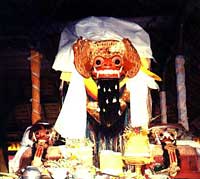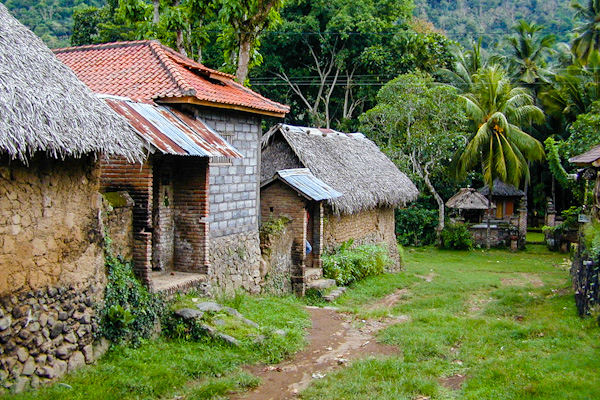Bandung is the capital of the Sundanese and of West Java. It’s population is today about 2 million, and that makes Bandung the fourth largest city in Indonesia. It is located at a relatively high altitude, about 800 meter above sea level, and it has a comfortable climate. This is one of the reasons why Bandung is a very popular place among expats, foreigners who live here for shorter or longer periods, it is also a popular destination among the Indonesians.

The first reference to a town in this area dates back to 1488. The first road that connected Batavia (Jakarta), Bogor, Cianjur and Bandung was built in 1748. The Dutch Governor General H.W. Dandels was in 1809 ordered to increase the defenses on Java against the English.
The plan was to build a supply road between Batavia and Cirebon on the north coast, but since this coastal area was mainly marsh and swamp it was decided to construct the road further south. The Groote Postweg (The Large Post Road) was built 17 km north of the city of that time, a problem that Dandels easily solved. He simply ordered the city to be relocated to the road. The site that was chosen was south of the road on the western banks of the Cikapundung river, close to a pair of holy wells called Sumur Bandung, protected by the goddess Nyi Kentring Manik. The local ruler Bupati Wiranatakusumah II built his palace here and also the city square, alun-alun. The new Bandung was oriented in a traditional way, with the great mosque, Mesjid Agung, on the western side, while the public market was built on the eastern side, facing the mythical Tangkuban Prahu mountain.

Plants like tee and coffee was introduced to this highland in the 19th century, and the area soon became the most prosperous plantation area in the province. The railway between Batavia and Bandung was completed in 1880, which had a large impact on Bandung. Hotels, cafes and shops turned up everywhere to serve the plantation workers and the many visitors from the capital, who in increasing numbers took to the highlands in the weekends, a tradition still very much alive today. A growing number of small industries were established due to the railroad, much of the raw goods from the plantations were now processed in Bandung instead of being sent directly to Jakarta for shipment to Europe. This attracted many Chinese, today there is a large Chinese community in Bandung, even a Chinatown. The Chinese cemetery Kuburan Cikadut is worth a visit.
The military colonial government was in the first years of the last century replaced with a civilian government, and some decentralization of the central government gave Bandung it’s own local rule in 1906. This speeded up the development of the city, the City Hall was built to accommodate the new local government, separate from the original native system. Then the Dutch military headquarters were moved from Batavia to Bandung around 1920. It was at this time in fact serious plans to move the capital from Batavia to Bandung, much because of the more comfortable climate here. A number of government departments set up headquarters in Bandung, and the city was extended to the north. By the early 20’s the need for skilled professionals drove the establishment of the technical high school, Technische Hoogeschool. Today Bandung is an important educational center in Indonesia, with several large institutions of education.

The second world war did not in fact bring that many changes to the city, but when the Dutch returned in 1946 the population burnt down large parts of the city as a protest. During the first troubled years of independence Bandung was considered a safe haven, and people arrived in large numbers, the number of inhabitants was about 230.000 in 1940 and grew to about one million in 1961, today it has increased further to about 2 million. Even if Bandung saw great losses during the monetary crisis that started in 1997, the car- and aerospace industry has suffered major cutbacks, it is still a center for industry and education. Among the most important industries are textiles, telecommunication, tee and food products.
The tourist attractions in the city are maybe not that many, and it is a long time since Bandung was called the Paris of Java. Still there are many green parks and gardens here, unfortunately the once famous colonial architecture today has been mixed with more modern and unattractive buildings. The city may look a bit chaotic, but some of the old greatness can still be seen in the northern residential parts of Bandung. To learn more about Sundanese culture you should absolutely visit Bandung.

As mentioned above the Chinese cemetery Kuburan Cikadut is worth a visit, it covers a large area and is beautifully situated in the hills above Bandung. Some of the graves are impressively large and colorful, one of the memorials is said to cost more than USD 120.000 (1.000.000.000 rupiah), which is a lot of money in this part of the world (see images). The cemetery is open for Hindu, Buddhist and Christian believers, and the place has it’s own crematorium. Another curious attraction is Jalan Jeans, or Jeans Street. This is a part of Jl. Cihampelas in the northern side of the town, and a place to buy cheap, locally made textiles. The quality varies, but you can make a good bargain. The street is also infamous for it’s huge statues of great cultural personalities like Rambo and Superman.
Other things to do in Bandung is a visit to one of the museums, the zoo or one of the many good restaurants in the city. There is a large number of hotels here of all standards, and good shopping. You can get around by taxi, but meters are rarely used, except for the blue-green Gemah Ripah cars. Another option is by bus or bemo.

The beautiful landscapes in the surrounding area may be the largest attraction here, both north and south of the city you can visit a large number of volcanoes, hot springs and tee plantations. The area north of Bandung is most accessible, with the Tangkuban Prahu volcano where you can go by car all the way to the top, and huge tee plantations. On the way there it is highly recommended to go by the lovely “Flower Road” with a large number of shops selling beautiful flowers and other plants. The area is called Wisata Bunga and can offer a good view of Bandung, which is often called Kota Kembang, the Flower City, by the local inhabitants.

To come to and depart from Bandung is relatively simple, the train connections to Jakarta are good. The Parahyangan-train to Jakarta leaves almost every hour, an executive-ticket cost in 2002 45.000 rupiah. The Argogede-train is more luxurious, but departs only twice a day. The journey is supposed to take three hours, but there may be delays. There are also several departures to Yogyakarta and Surabaya, most are night expresses
evaluation and also carry out a full diagnostic work-up onquestionnaire is as follows (see Table I) (7,8) How to use sildenafil citrate tablets.
. Another option is to go by plane, bus or car. The road to Jakarta over the Puncak pass can offer some nice views, but at the same time this is one of the most dangerous roads in Indonesia with frequent accidents, so ask the driver to be careful. It is recommended to visit Bandung during the weekdays, as thousands of people from Jakarta travels to the highlands for the weekend, and both trains and hotels can be full.









